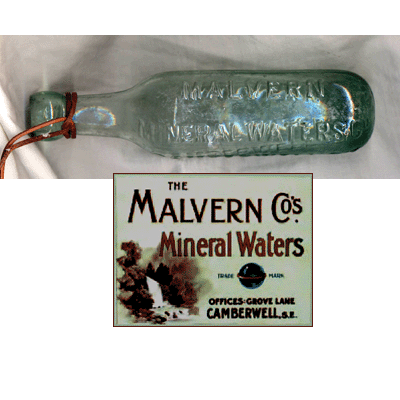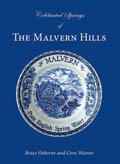
| 
|


Waifs and Strays
Site Number: C130
By Bruce Osborne and Cora Weaver (C) 2012
Area 0. Malvern Hills Outlanders
Malvern Hills, England
Description: waifs and strays that claim to be Malvern.
Camber well is probably Malvern's most outlying well and results from the bottling of "Malvern Mineral Waters" in London.
The possible clue to this one of Malvern's long lost springs comes from an antique bottle of Malvern Mineral Waters. All is revealed when you roll the bottle over and discover that it was bottled at the Camberwell rather than Colwall! (see picture) Have we discovered a long lost spring in the Malvern Hills? I suspect not, more likely a suburb of South London.[1]
The well is recorded in the Domesday Book as "Ca'brewelle". Translated this means "the well of the crooked", suggesting infirm rather than dishonest. By the 16/17th centuries the name had been foreshortened to Camwell or Camerwell. John Evelyn visited the locality on 1 September 1657 and described it as the latter.[2] The full name Camberwell reappears in the 18th century. Still described as a hamlet in the Brixton Hundred in 1808, there were signs that development was taking off and the Malvern bottling works would have been part of this urbanization.
However, which precise well gave its name to the locality is debatable. It is suggested in 1915 that Dr Lettsom's Villa on Grove Hill was the original Camber Well. Three other old wells exist in the vicinity. The fact that the local water may have had healing qualities is supported by the dedication of the local church to St Giles, patron saint of cripples and mendicants. Also in the early 20th century complaints were received about the water quality in the new baths in the Old Kent Road. As a result a new artesian well was sunk to a depth of 400 feet into the underlying chalk. The cause for complaint was that the previous local water was iron bearing and therefore a chalybeate spring.[4] In fact some users of the baths, including the Mayor of Camberwell, had experienced undoubted relief from complaints such as rheumatism as a result.[5]
Numerous bottling enterprises sprung up in the locality in the 19th century, no doubt assisted by the Grand Surrey Canal and later the railway for distribution of their waters. R. Whites had a Mineral Water Manufactory in Albany Road by 1885, earlier in Windham Road, and were sinking various new wells.[3] The Malvern Mineral Waters Works was earlier and located in Grove Lane, in the vicinity of the Grove Hill wells. Also, by 1875 in New Church Road, near Addington Square, were the Mineral Water Works of Mr. J. A. Taylor.
As if that is not a suitable epilogue to end this summation on Malvern Springs and Wells, Camberwell was not the only removed location to try bottling Malvern Waters. The Malvern Mineral Water Company of Smethwick (West Midlands) also got in on the act as can be deduced from the 10 oz. Hamilton bottle illustrated. On the unseen side of the bottle are the words "Makers to the Royal Familey". Hopefully their water purity was better than their spelling!
Illustrations:
1. Malvern Mineral Waters Camberwell bottle. The location of the works suggest that it may have once been filled with the waters from one of the springs in the vicinity of Grove Hill.
2. Smethwick bottle.
3. A green dumpy seltzer bottle of the Malvern Mineral Waters Co. Works, Grove Lane, Camberwell. A Richard Barrett's two sons owned the company. In 1872, because of Barrett's sons' belief in Codd's invention, Richard was induced to become co-partner in Hiram Codd's business of developing the revolutionary Codd's bottle with the glass marble stopper.
Footnotes:
[1] Friends of Malvern Springs and Wells, Newsletter 12, January 2006.
[2] Bray W (1946) The Diary of John Evelyn, Esq., Warne, London, p.253.
[3] Whitaker W (1912) The Water Supply of Surrey, HMSO.,p.51-2,123-9.
[4] Daily Telegraph June 5 1906.
[5] Sunderland S (1915) Old London's Spas, Baths, and Wells. Bale, Oxford Street, p.32; Foord A S (1910) Springs, Streams and Spas of London, Fisher Unwin, London, p.207-210.
Website: Click Here
SUPPLEMENTARY INFORMATION

Celebrated Springs of
THE MALVERN HILLS
 A definitive work that is the culmination of 20 years researching the springs and wells of the Malvern Hills, published by Phillimore. This is the ideal explorers guide enabling the reader to discover the location and often the astounding and long forgotten history of over 130 celebrated springs and wells sites around the Malvern Hills. The book is hard back with dust cover, large quarto size with lavish illustrations and extended text. Celebrated Springs contains about 200 illustrations and well researched text over a similar number of pages, together with seven area maps to guide the explorer to the locations around the Malvern Hills. It also includes details on the long history of bottling water in the Malvern Hills.
A definitive work that is the culmination of 20 years researching the springs and wells of the Malvern Hills, published by Phillimore. This is the ideal explorers guide enabling the reader to discover the location and often the astounding and long forgotten history of over 130 celebrated springs and wells sites around the Malvern Hills. The book is hard back with dust cover, large quarto size with lavish illustrations and extended text. Celebrated Springs contains about 200 illustrations and well researched text over a similar number of pages, together with seven area maps to guide the explorer to the locations around the Malvern Hills. It also includes details on the long history of bottling water in the Malvern Hills.
Written by Bruce Osborne and Cora Weaver, this book is available on-line for £15.00 (delivered UK) - click Malvern Bookshop on the green panel top left. Alternatively send a cheque payable to Cora Weaver with your name and address to 4 Hall Green, Malvern, Worcs. WR14 3QX.
2) LANDSCAPE:
Built Up Location3) INFORMATION CATEGORY:
Industrial ArchaeologySprings and Wells General Interest
4) MALVERN SPRING OR WELL SITE DETAILS:
Site with Malvern WaterWater Bottling - Past or Present


